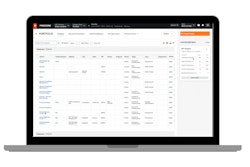
With general and specialty contractors piling onto digitalization and digital transformation at an increased clip, with a pandemic to help the trend a long, market leader in software-as-a-service (SaaS) construction project management software Procore was well positioned for its initial public offering in May of 2021, raising $20 million more than expected.
By that time, Procore had been developing and marketing construction project management software for almost 20 years, starting with software for residential and commercial contractors consisting of core construction management, bidding, contract management, change orders, scheduling, requests for information (RFIs), submittals, transmittals, punch list and other tools, including iPhone and Android apps. The company received a regular stream of venture capital between 2004 and its IPO, racking up $374 million that helped them broaden out its offering through organic development, and an impressive list of acquisitions including:
- Levelset 2021 B2B payments platform for construction
- LaborChart 2014 Resource scheduling and management
- BIMAnywhere 2018 Mobile BIM collaboration platform
- Honest Buildings 2019 Cloud-based project management and procurement
- Esticom 2020 Cloud-based takeoff and estimation software
- Indus.ai 2021 Digital twin platform for construction
Today, Procore is the most dominant enterprise software provider in construction, which makes it the first port of call for emerging best-of-breed solutions and apps when it comes to integration. The company has more than 400 software and integration partners, which increases the value proposition and collaborative power of Procore while cementing their place in the market.
Procore’s freemium business model is aimed at inclusion of all parties in the construction project, enabling generals or owners to open free accounts in Procore to their subcontractors and collaborators. Procore can then work those free users as a back door to drive new paid subscriptions.
Procore Roadmap and Investments
With major competitors, some like Autodesk Construction Cloud and Trimble Construction One, with major corporate backing and resources banging on the door, Procore is not expected to sit idle and be overtaken.
“What I am always focused on is research and development as a percentage of revenue—we are at about 28 percent which is a little hot for an SaaS company, but we are also a vertical SaaS, and we service an industry where that has a lot of different solutions inside of it. We feel it is key to our growth to continue to innovate,” Procore Senior Vice President of Product Wyatt Jenkins said curing our July 2022 debriefing session.
Procore may well drive down that R&D as a percentage of revenue number through both process efficiencies and Jenkin’s focus on extending the product through partnerships and integrations rather than home baked software. But Procore is in the admirable position of splitting the difference between venerable solutions born for on-premise operations like Sage 100 Contractor, Sage 300 Construction and Real Estate, Trimble’s Viewpoint product line, Foundation Software and others and cloud products like Sage Intacct. Procore has been in the market long enough to have evolved deep functionality yet to be developed within a product like Intacct while delivering a more complete solution even without multiple integrations with outside solutions required to address core requirements as would be required by major cloud ERP vendors like Microsoft Dynamics, Oracle Cloud ERP or SAP.
According to Jenkins, Procore is focused on four key initiatives with regard to the product and the company’s direction, and these should help contractors understand where the company is headed in the next several years:
- International expansion, including presences and new boots on the ground in France and Germany—Procore already has established footprints in the UK, Australia and Canada. Within the product, contractors can expect to see support for additional languages, currencies and local regulations.
- Continuous investment in financials. While Jenkins said Procore will not extend into the general ledger where it currently integrates with financials packages, the company long ago came to encompass the entire quote-to-cash cycle. Contractors will find many recent and pending product improvements in invoicing, work breakdown structures (WBS) and expanded integrations with external ERP products. “Our Honest Buildings acquisition in 2019 is where our construction financials came from, and that is now being rebuilt inside Procore,” Jenkins said. “That is now mature and something more and more of our customers are using.”
- Collaborator experience, which is central to Procore’s freemium model, is also front and center. The Procore Construction Network, a multi-vendor marketplace for contractors, is now a contiguous part of the interactions subcontractors, generals and owners working on projects can access.
- Apart from functionality within the platform, they are focusing on the data they have accumulated through being the dominant player in the space on a significant percentage of construction projects in North America and some in other countries. The company hired Joy Durling as their first chief data officer in April of 2022. “We are sitting on the most incredibly rich data,” Jenkins said. “We are starting to do things like construction insurance, payments--business lines that are based on data.”
The expansion into financial services, which originated with the acquisition of Levelset and parallel to efforts from start-ups like Constrafor, essentially enables Procore to use information they possess about their customers to prequalify them for loans and other services.
“When you are doing material financing or insurance, you need to underwrite, and we have the data in Procore to do that underwriting,” Jenkins said. “We know how projects go, whether there are safety risks and whether RFIs are getting done on time. People may see Procore as a great SaaS company, but we are turning into more of a data company.”
This deep data set enables Procore to offer the right financial services to the right contractor at just the right time.
“We have a bidding product—the bid goes out to specialty contractor, five contractors bid, and it goes back into our bidding tool,” Jenkins said. “When a subcontractor is notified they won the bid, we send them a second email offering financing for the exact amount required for materials. We can write that in the moment, with a pre-qualified subcontractor on the other side of that transaction. We know all the customers bidding and we know all the data from both sides of the transaction to power underwriting.”
While Procore looks to extend and monetize the data they have on their customers and their projects, they are also introducing new functionality at a fairly rapid clip across the application suite. A few examples of net new or improved functionality launched or close to release in 2022 include:
- The Procore Construction Network, which was launched in 2021, now gives free users enhanced control over the information presented on a company in the network, including new abilities to display projects or open projects, and tools to interact with their account.
- In Preconstruction, users will find a new bid forms experience—with one scope of work for all invited bidders. Contractors will have an easier time configuring bid forms, and once bids are submitted, they can compare them side-by-side to select winners and identify risks.
- Estimators will find new automated area takeoff, enabling them to take off floor plans and rooms in a single click—saving 90 percent of the time they currently spend on this process.
- Communication and correspondence between project collaborators are enhanced with new multi-step workflows with mobile push notifications, automated email notifications and the ability to add custom fields for mobile, subjob and scheduled paths.
- A daily log schedule tool—featuring an updated interface for a more consistent user experience when searching and managing logs across multiple days, with the ability to relate items from across Procore to Daily Log entries.
- Users can now also export PDF versions of the Gantt chart from the schedule within Procore.
- Procore BIM now supports Android to streamline sign-off of coordination models on the site, something that had previously only been available to iOS users.
- Users can now save BIM files directly to Procore’s Documents tool from authoring and analysis applications, so BIM files are more easily accessible from Procore. In the Documents tool, users can also now view Revit files, eliminating the need to use Navisworks.
- Net new functionality Procore QuickCapture enables faster punch walks … users can create punch list items by recording videos, while transcribing voice recording to automatically fill out the item description.
- Users will find new features for simplified time entry for project teams. Within LaborChart, Procore has enhanced tools to create requests and assignments for field and office staffs with the ability to hide assignments until they are finalized and ready to send out.
- Procore Conversations, an embedded collaboration tool streamlines communications across companies through direct messaging and open threaded discussions—this was in pilot at the time of the update.
Jenkins referenced a heavy focus on financials, and this is borne out by the long list of new features released to market:
- An always-editable schedule of values on commitments so financial managers can make controlled changes to the commitment schedule of values even after invoices or change orders or invoices have been entered against them
- A modernized experience for prime contracts and commitments, with all the information now on one page and faster navigation
- Increased visibility to potential financial impacts in the Change Event list, including grouping and filtering features
- More flexibility for budget changes including zero net transfers or increases, replacing previous modifications functionality, so changes to the budget can be handled without creating a dummy change order
- Stronger integration with Sage 100 Contractor, Sage 300 Contractor and Intacct Construction including job cost detail, invoicing and payments
- Analytics improvements including support for work breakdown structure, with reporting across budget code and the ability to build custom reports around the WBS
- An enhanced report builder that enables reports to be created across different Procore tools
Procore Tech Stack
Procore is provisioned on Amazon Web Services and operates on a continual release cycle. Engineers working on Procore can ship code as soon as it is ready, but customers can still choose when to push it live in their instance of the software—an important consideration to avoid confusion among the user base.
This continual release cycle enables the rapid development and improvements often associated with the multi-tenant SaaS delivery model—with every customer always having access to the current product through incremental and ongoing updates as opposed to a big bang upgrade. But a continuous release cycle on SaaS also enables more frequent bug fixes and security patches. This helps Procore get patches in place to its own code and open-source technologies it uses in its middle tier and interface.
Procore delivers a high level of data security and visibility into its software’s operation and has achieved an array of certifications in these areas including
- American Institute of CPAS (AIPCA) SOC 1 Type 2—which documents the fairness of the presentation of management’s description of the service organization’s system and the suitability of the design and operating effectiveness at achieving control objectives.
- AIPCA SOC 2 Type 2—which documents internal controls and reveals how a company safeguards customer data and how well those controls are operating.
- Contractors engaged in work for the federal government benefit from National Institutes of Standards and Technology (NIST) SP 800-171 compliance, which outlines requirements for protecting the confidentiality of controlled unclassified information (CUI).
- ISO 27001:2013, from the International Standards Organization, lays out the best practices for managing information security around people, processes and technologies.
AWS includes extensive data security tools, including NIST SP800-171 through its GovCloud offering. As Procore has acquired products, they have migrated them to AWS as a matter of course, and increasingly compatibility of the tech stack has become a priority for acquisitions Procore engages in.
“We built a data platform,” Jenkins said. “We have had a few acquisitions not on AWS, and we had to get them on AWS. We have a process up and down the stack at the data level for integration. If it is going to be very hard to integrate something, I’m probably not going to do the deal.”
This common data platform is important as Jenkins and his team are working towards giving contractors enhanced visibility of the contract lifecycle from quote to cash.
“If you are estimating something, today we are working on something that pushes the initial estimate through to our financials so you can connect the initial estimate to the reality of what happened,” Jenkins said. “We’re experimenting with AI to give you insights based on the data we round trip between estimating and financials.”
To facilitate this, Procore has moved away from its past practice of taking the multiple code lines of acquired products into the core product for a unified architecture based on a common set of master data and towards an integration strategy akin to what Gartner talks about with its term “composable enterprise.”
“I like to do acquisitions that have a clear integration,” Jenkins said. “We are pretty cautious—with our older acquisitions, the strategy was to acquire and then rebuild into Procore, eliminating the need for a separate code base. That is a lot of work. A lot of our more recent acquisitions have a clear path to being fully integrated. We did Esticom in 2020—now at this point it is Procore Estimating—just a SKU inside of Procore. Customers don’t even know it was an acquisition. LaborChart has been relaunched as Workforce Management inside of Procore. This matters in our industry--there are competitors that buy a whole lot of stuff with random tech stacks."
Pricing and Market
Procore’s freemium pricing model is well publicized, with the subscription being determined by a combination of a percentage of construction volume and the extent of Procore functionality a contractor uses.
This percentage will be, according to Jenkins, between 2% and 5% of construction volume depending on which SKUs a contractor subscribes to. Jenkins said the price allows for a healthy return on investment based on studies that suggest an 11% reduction in cost is par for the course. This includes unlimited seats and the ability to extend free accounts to unlimited trading partners.
IronPros hears from Procore end users about other costs associated with the product—most notably costs associated with extracting data from Procore. Jenkins acknowledges this is a challenge they are working on.
“We don’t intend it to be complicated, but we have not built out our data extracts to be super robust yet,” Jenkins said. “If people want more complex data out of Procore, they may have a fee for professional services … but it is not like a big SKU for us or something we want to sell. It is not the way I think about making money—it is not a meaningful percentage of our revenue. But we still have to make it easy, and that is on us to build that out to make it easy. And if it not easy, sometimes you have to get a third party involved.”
Jenkins said enhanced data extraction tools are on the roadmap in the form of specific data connectors.
“We are working on it, but it is not anything reflected in user experience today,” Jenkins said.
The pricing may be well-supported by the value equation, and the addressable market is large as the broad spectrum of capabilities Procore offers make contractors with more than a handful of employees prospects. Different parts of the offering may go further down market than others, to smaller contractors, while the core project management offering can scale all the way up to the largest contractors.
Labor Chart will be viable well down market, and Jenkins characterized their materials financing offering as being aimed at small specialty contractors and generals who self-perform and want to establish or protect their existing lines of credit. Contractors too small to even be a prospect for these offerings though can still create a profile on the Procore Construction Network.
Project owners are also implementing Procore, putting them head-to-head with e-Builder, now owned by Trimble.
“For owners, financials and construction management is our strong point,” Jenkins said.
BOTTOM LINE: Procore is broadly used enough to become almost like a utility across segments of the construction industry, delivering modern multi-tenant SaaS that still has the functional richness of a solution that has been in the market for a while. As a public company, it is not likely to be acquired, and that shields users from finding their vendor has been snapped up and the product they relied on back-burnered or discontinued. It is not the only broad application for construction and with its pricing model, not the cheapest. At IronPros, we are hearing of some contractors moving off of Procore and onto either the Sage construction ERP products, Trimble Construction One or Autodesk Construction Cloud, primarily to cut costs. Sage has said plainly that they plan to move all of their Sage 300 Construction and Real Estate customers onto Intacct once that multi-tenant SaaS product reaches functional parity, so the wisdom of moving in that direction from a more modern product with a strong future seems questionable. In selecting between Procore, Autodesk Construction Cloud or Trimble Construction One, any cost savings should be balanced against not only the flow of innovation and research and development investments at Procore but the size of the partner network. Contractors who want flexible access to their data for external reporting, analysis or integrations will want to lean on Jenkins and Procore about the release of data extraction tools, which may be challenging to deliver as a hangover from disparate architecture of acquired products.















